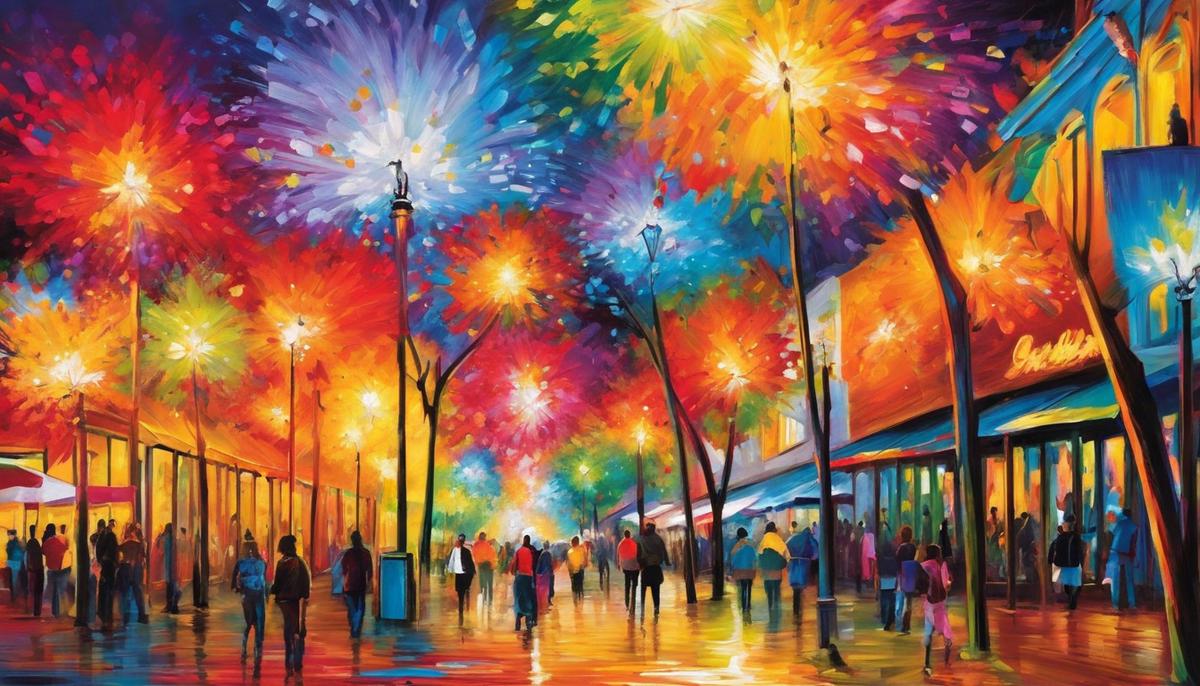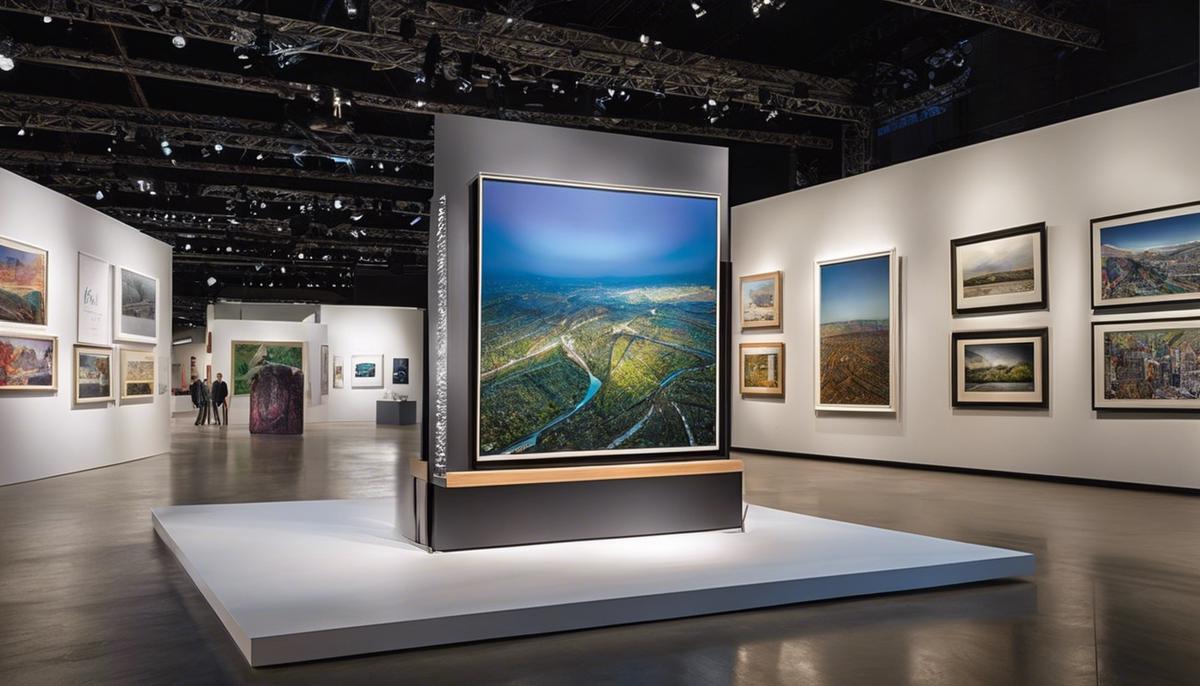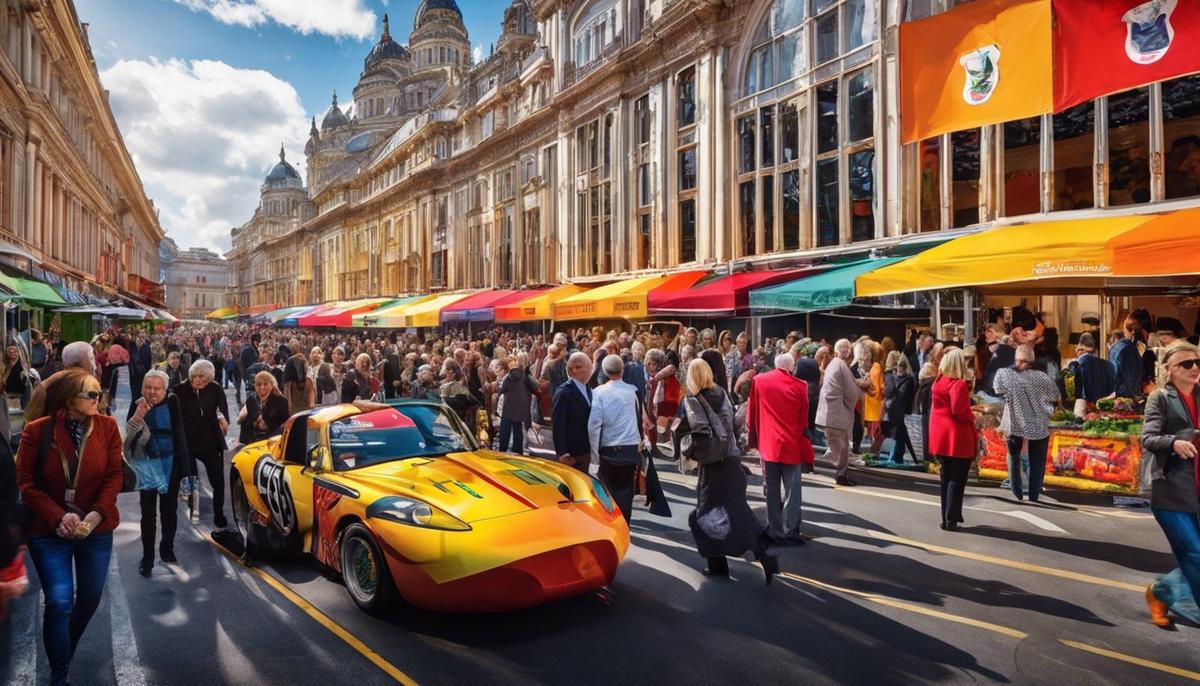The international stage for art showcases itself most prominently at the multitude of art fairs that grace global cities with their dynamic presence. These fairs are not merely exhibitions but locomotives of economic and cultural significance, driving forward an industry steeped in tradition yet ceaselessly pursuing innovation. As one delves into the economic labyrinth of these events, one discovers a complex web where the creation and appreciation of art fuel robust financial transactions, propagate global networks, and anchor the very sanctuaries that cradle creative human expression. They are at once marketplaces and melting pots, where the pulse of contemporary culture beats loudest and where the aesthetic preferences of society are both reflected and directed. The following discourse aims to shed light on the intricate roles that art fairs play within the tapestry of the global art market, weaving through its economic strata, cultural narratives, and social intricacies with a critical but appreciative eye.
Economic Significance of Art Fairs
The Catalytic Role of Art Fairs in the Global Art Market
Art fairs hold a significant place in the intersection of culture, commerce, and connectivity. These dynamic events engender a multitude of effects that actively stimulate the global art market. Understanding the multifarious mechanisms through which art fairs exert influence necessitates an exploration of their role in market expansion, networking opportunities, and the dissemination of artistic trends.
Market Expansion Through Concentrated Exposure
At the heart of an art fair’s impact is its ability to aggregate a vast array of artworks under a single umbrella, offering concentrated exposure to diverse artistic expressions. Galleries from across the globe assemble their finest pieces, bringing emerging talent and established artists into the limelight. This collective showcase potentiates the visibility of artists who might otherwise be confined to local or regional recognition.
The congregation of a myriad of artworks in one locale effectively establishes a microcosm of the global art sphere. Collectors, curators, and enthusiasts converge to experience this condensed version of the market’s breadth and depth. Art fairs function as a crucible for commerce, where transactions are initiated and concluded, often at a brisk pace. This intense trading activity directly contributes to the vitality of the global art economy, fostering sales that echo through the artists’ studios, galleries, and ultimately, the broader market.
Forging Networks and Cultural Exchange
Art fairs are not merely commercial hubs but also hotbeds of networking and cultural exchange. They facilitate interactions among disparate art market actors, including artists, gallery representatives, collectors, and critics. These encounters enable relationships to stratify into collaborations that can span continents and cultural boundaries. For many artists and galleries, forming a nexus at an art fair is a strategic maneuver to extend their networks and solidify their standing within the international art community.
In addition to individual connections, art fairs often engender institutional links. Museums and public galleries scout for acquisitions and exhibitions. Art fair attendees witness trends materialising in real-time, which can shape collective tastes and artistic directions. This exchange of ideas and aesthetics has the potential to influence future art productions and market inclinations.
Transference of Artistic Trends
Aligned with the aforementioned cultural exchange is the transference of artistic trends that occurs during art fairs. These events are not only transactional in nature but also serve as barometers for the current artistic climate. Dealers and collectors observe emerging tendencies and market preferences, information that is inherently valuable for predicting and adapting to the ever-evolving tapestry of art demand.
Furthermore, art fairs often include a program of talks, workshops, and discussions that delve into contemporary art issues and theoretical underpinnings. These educational aspects enrich the experience, serving as a nucleus for the dissemination of new ideas and critical thought. The fusion of academic discourse with commercial display underscores the symbiotic relationship between intellectual and economic facets of the art world.
Conclusion
Indeed, art fairs are indispensable to the sustenance and growth of the global art market. They encompass multiple layers of influence, fostering economic transactions, networking opportunities, and the propagation of new art forms and ideologies. Their recurring presence on the art world’s calendar continues to be a vital pulse, ensuring the vibrancy and adaptive progression of a market that thrives on diversity and cultural dialogue.

Cultural and Social Dynamics at Art Fairs
The title: Unveiling the Sociocultural Tapestry of Art Fairs
Art fairs, by their nature, are cultivators of societal and cultural landscapes, serving as dynamic forums where diverse perspectives collide and coalesce. These institutions transcend mere marketplaces; they are microcosms of the communities they inhabit and influential spaces that shape societal tastes and values.
A focal point of consideration is the democratisation of art access. Art fairs, in essence, have altered the public’s interaction with art by creating more inclusive environments. The spectator is no longer a passive entity but an active participant, engaging in dialogues with artists and the art community. This breaks down the barriers of art elitism and encourages a more educated and diverse audience to appreciate and invest in art.
In a social context, art fairs can serve as catalysts for urban renewal. Cities hosting large-scale art events often experience a renaissance of sorts where neglected areas are revitalised, becoming burgeoning cultural districts. Such transformation not only boosts the local economy through increased tourism and employment opportunities but also instigates a sense of pride and communal identity rooted in a shared appreciation for the arts.
Furthermore, art fairs hold a mirror to contemporary societal issues, often embodying the zeitgeist within the creative expressions showcased. Through a variety of mediums, artists illuminate the complexities of identity, politics, and the human condition, prompting reflection and potentially affecting collective consciousness. In this regard, art fairs are not merely events but platforms for discourse and vehicles for social commentary and change.
It is imperative to acknowledge the educational value inherent within art fairs. They often encompass a program of talks, workshops, and immersive experiences that serve to enlighten both seasoned aficionados and novices alike. This dissemination of knowledge not only enriches the individual’s understanding but also fortifies the social fabric through shared cultural learning experiences.
In conclusion, art fairs exist at the intersection of culture, society, and economy, reflecting the interconnectedness of these realms. They are the resonant spaces where art is not only seen but felt, challenging and shaping perspectives, transforming spaces, and nurturing human connections. As such, their significance in the contemporary world cannot be understated; they are both a product of our times and a definer of our cultural legacy.
Image source:

Critical Perspectives on Art Fairs
Art fairs, with their dynamic blend of commerce and culture, stand at the forefront of the art world’s public interface. Yet, they are not without their significant challenges. These obstacles span the logistical, ethical, and aesthetic realms of the art industry.
Firstly, the environmental impact is an ever-growing concern. Art fairs necessitate extensive travel for exhibitors, collectors, and enthusiasts alike, resulting in a substantial carbon footprint. The construction of temporary structures, although ephemeral, utilises substantial resources and energy, raising questions about sustainability practices in the context of art promotion and appreciation.
Furthermore, the financial accessibility of art fairs poses a dichotomy. While they can democratise access to art, the cost of attending, exhibiting, and purchasing art remains prohibitive for many. This financial barrier can perpetuate exclusivity within the art world, running counter to the ideal of broadened access.
From a curatorial perspective, the representation of artists within art fairs has come under scrutiny. Despite global participation, there is an observable bias towards Western artists and art forms, which may inadvertently uphold a narrow cultural narrative. The challenge, therefore, resides in ensuring equitable representation and avoiding the consolidation of an art world hegemony.
Moreover, the temporal nature of art fairs often prioritises short-term spectacles over long-lasting contributions to the art community. The transitory buzz must be counterbalanced with sustained engagement strategies to ensure a lasting impact on local art scenes and artist careers.
Lastly, with the integration of digital platforms and the rise of virtual fairs, the digital divide becomes an apparent hurdle. Equal access to technology and the digital literacy required to engage with art in this new stratum must be addressed to prevent a widening gap between the technologically enabled and those without such access.
In sum, art fairs must conscientiously navigate these challenges to continue evolving as inclusive, sustainable, and reflective platforms within the expansive tapestry of the art world.

Evolution and Future Trajectory of Art Fairs
The evolutionary trajectory of art fairs is a fascinating juncture to dissect, marked by an avant-garde blend of tradition and innovation. Stepping away from the well-trodden path, these kaleidoscopic gatherings are reshaping the tapestry of contemporary art presentation. This brings us to an exploration of forthcoming trends that can be anticipated within this dynamic and flourishing realm.
Intertwining technology with the visceral experience of art, art fairs are increasingly incorporating augmented and virtual reality. Beyond mere spectatorship, these tools proffer an immersive sojourn into the artists’ vistas. The potential here is boundless; one can envisage patrons navigating digital galleries from their personal devices, interacting with art in three-dimensional worlds, and perhaps even witnessing the inception of a piece in real-time through artist-led virtual workshops.
Another discernible trend is the conscientious adoption of sustainability measures. Foresight dictates that art fairs transition towards eco-friendly practices, reducing their carbon footprint. This could involve supporting local artists to lessen transport emissions, utilising recyclable materials for installations, and eschewing paper for digital catalogues. The art community is increasingly cognisant of its role in championing sustainable futures; thus, this trend is not merely prediction, but a necessity.
In addition, the financial landscape of art fairs is bound for transformation. The burgeoning model of microtransactions, akin to those found in digital gaming platforms, may find its footing within the digital annexes of art fairs. This model could enable patrons to invest in fractional shares of artwork, thereby dismantling traditional economic barriers and granting wider access to the art market.
The aforementioned cross-pollination of technology will also see further strides in addressing the digital divide. As art fairs venture into the digital world, ensuring equitable access is paramount. Strategies may include partnering with educational institutions to provide digital literacy programs or launching outreach initiatives in underserved communities, thereby cultivating a more inclusive art audience.
A final contemplation is upon the aesthetic and thematic content of future art fairs. In an era beset with digital saturation, a counter-movement may emerge, celebrating art forms that engage the tactile senses or invoke nostalgia for analogue processes. Concurrently, the thematic preoccupation of art fairs will likely mirror global events more acutely – a reflection of society’s pulse, from pandemic repercussions to humanitarian crises.
In considering these patterns, one discerns that art fairs are not static entities but vibrant organisms perpetually in flux. They serve as barometers for broader societal shifts whilst also propelling the vanguard of cultural conversation. The landscape of art fairs is on the cusp of a renaissance, spearheaded by the seamless incorporation of technology and an uncompromising commitment to sustainability and inclusivity. As they chart this new frontier, they will undoubtedly continue to inspire, challenge, and redefine public engagement with the profound world of art.

Through the ebb and flow of economic tides and the ever-evolving zeitgeist of cultural expression, art fairs have proven to be resilient and adaptable entities within the art world. They offer a prism through which the spectrum of contemporary art is both viewed and influenced—a platform for dialogue, exchange, and innovation. The trajectory of art fairs signals a continuous evolution, ripe with potential for redefining accessibility, fostering inclusivity and harnessing technology in the quest to connect art with its ever-growing audience. As these fairs march boldly into the future, they carry the mantle of both custodians and catalysts of the art market’s destiny, embodying the enduring human spirit that seeks to both create and comprehend the boundless realm of the visual arts.























